Physical Address
304 North Cardinal St.
Dorchester Center, MA 02124
Physical Address
304 North Cardinal St.
Dorchester Center, MA 02124
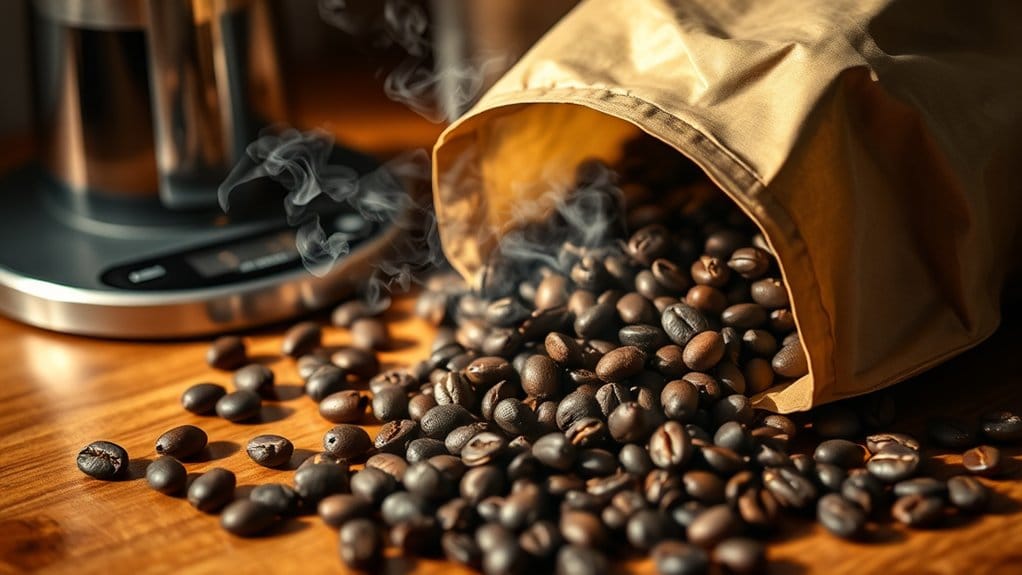
Coffee degassing is when roasted beans release carbon dioxide, and it’s super important for brewing a delicious cup! You’ll want to wait about 4 to 7 days after roasting for the best flavor. Brewing too soon can result in sour notes or muted flavors. Dark roasts degas quicker, whereas lighter ones take more time. So, be patient! Curious about how to store your beans or optimize your brew? Stick around for some tips!
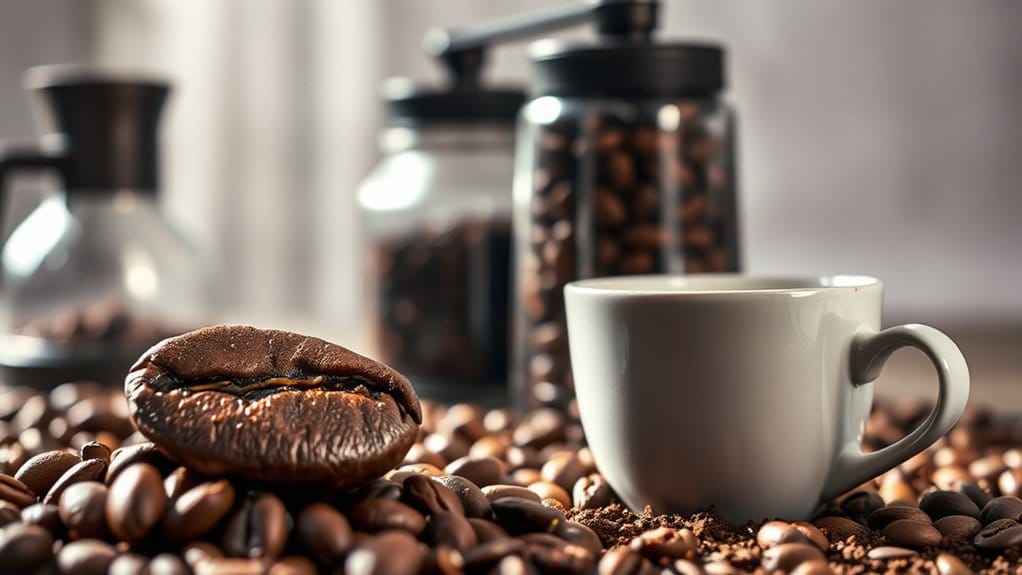
When you think about coffee, you might picture that rich aroma wafting through the air, making your morning a little brighter.
But wait! Have you ever thought about what happens right after roasting? Coffee degassing is that performance of CO₂ escaping from the beans. This release is crucial. Without it, your cup might taste sour or unevenly extracted. Imagine lifting that mug, only to be greeted by muted flavors! Different factors affect how quickly beans degas. Darker roasts release gas faster than light roasts, and natural-processed beans take their sweet time. Degassing timing is essential, as using coffee before it has properly degassed can lead to under-extraction. Excess CO₂ can disrupt water flow, impacting the overall flavor profile of your brew. Additionally, once opened, whole coffee beans should ideally be brewed within a week or two to prevent staleness. To enjoy the best taste, give your coffee beans a chance to breathe. Wait a few days—trust us, your taste buds will thank you!
Coffee degassing might sound like a fancy term, but it’s simply about how those rich, aromatic beans release carbon dioxide. When coffee beans roast, they heat up, transforming humidity into vapor and building internal pressure. The result? A delightful explosion of CO₂!
This gas rushes out during the first hours post-roast, but don’t expect the party to last forever. It slows down after a few days, settling into a more leisurely pace. Freshly roasted coffee has the highest CO₂ levels, and this is why waiting a few days can amplify your brew’s flavor profile. Advanced processing techniques often result in varying degassing rates, which can further enhance how we approach brewing coffee.
Different beans, grind sizes, and even how you store them can influence this process. Imagine your beans are little gas balloons—once you poke them with a grinder, they release that flavorful air faster.
It’s all part of the magic that makes your cup of coffee so delicious!

Degassing plays a crucial role in how your coffee develops its flavor. Imagine brewing a cup that’s full of bright, rich notes instead of a sour, muddled mess. Excess CO₂ can repel water, causing uneven extraction. This results in those underdeveloped flavors you don’t want.
By allowing those volatile gases to escape, you’re inviting all the aromatic oils and flavor compounds to shine. Light roasts especially benefit from a solid two weeks of degassing for mellow taste. Proper degassing can make your coffee clearer and more balanced, enhancing sweetness as well as reducing that biting acidity. You’ll notice the difference in aroma too. Additionally, the rate of degassing is influenced by factors such as roast level and bean density, meaning that different beans may require tailored resting periods.
Finding the right moment to brew can make all the difference in your coffee experience.
Ideally, wait about 4 to 7 days after roasting for most beans. This is when you’ll capture that perfect flavor!
If you’re feeling adventurous, try brewing pour over or French press methods as early as 2 days post-roast.
Just remember, espresso needs a bit more time—at least 5 days—so it doesn’t end up tasting sour.
Keep in mind that ground coffee loses gas faster, so it’s best to grind just before brewing.
Experiment a bit! Testing your brew at different intervals can guide you to your personal sweet spot.
After all, the best coffee is the one you enjoy most! Furthermore, understanding the importance of bean freshness can elevate your overall coffee experience and flavor.
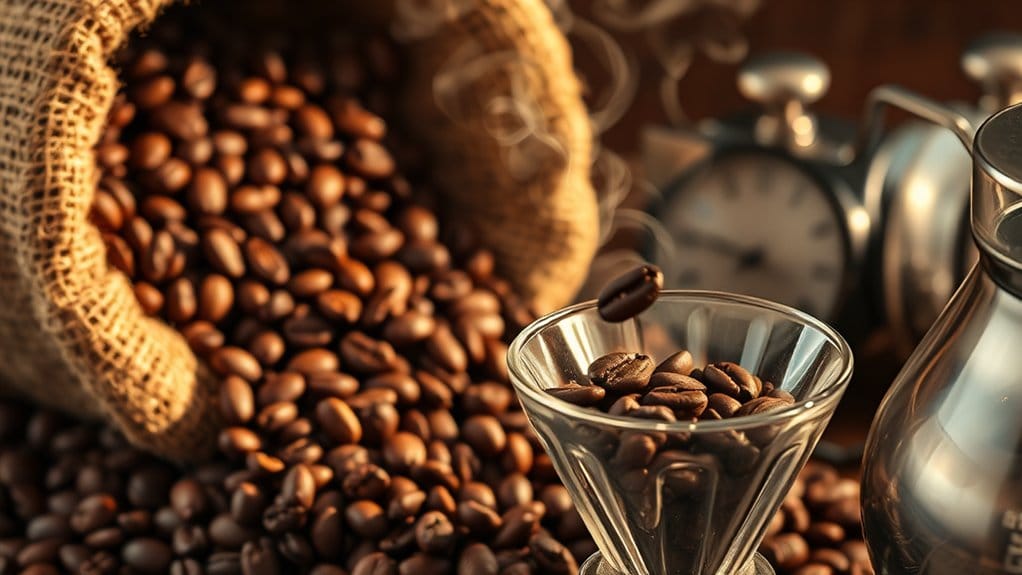
When you think about brewing your perfect cup, the roast level of your beans plays a key role in the degassing process.
Dark roasts, with their porous structure, release CO₂ faster, creating that caffeinated punch you crave. Since they degas quickly after roasting, you might be tempted to brew them right away.
But hold on! Lighter roasts keep more of their dense goodness, trapping CO₂ longer, which can make them taste flat if brewed too soon.
Imagine this: a dark roast may sing sweet notes quickly, whereas a light roast takes its time to reveal delicate flavors. Additionally, understanding the bean density helps explain why different roast levels degas at varying rates.
Have you ever wondered just how long to wait before brewing that fresh bag of coffee? It’s not just a guessing game!
After roasting, coffee starts to degas most notably in the first 24 to 72 hours. If you’re brewing espresso, you’ll want to hold off for at least 5 days. For pour-over, you can enter as soon as 4 days.
Remember, lighter roasts take longer than darker ones! Like a fine wine, coffee’s flavors mature over time. Most beans hit their peak between 3 to 14 days after roasting.
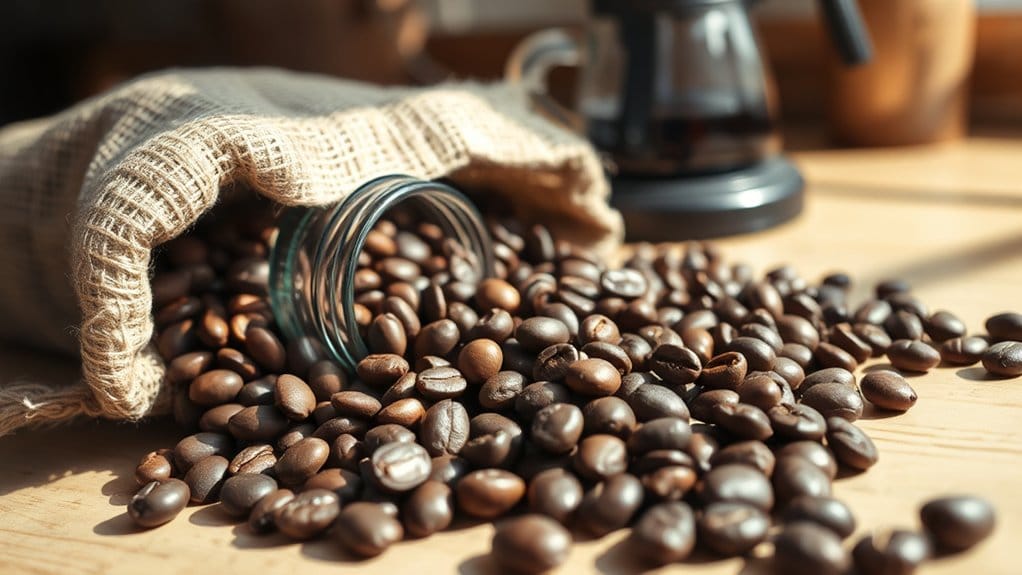
If you want to savor the full flavor of your coffee, storing those beans properly is vital!
First, consider using Mylar bags with oxygen absorbers; they keep air away and help your beans stay fresh. If you’ve got a vacuum-sealed container, that’s even better! It prevents stale air from sneaking in.
Remember to pick a cool, dry spot for storage, like a dark cabinet—no ovens or sunlight allowed! Opt for opaque containers to block out light and keep humidity at bay.
And let’s be honest, whole beans rock—they last longer and taste way better than ground coffee. So, if you want your morning brew to sing, treat your coffee storage with the care it deserves! Additionally, protecting coffee from light is crucial to maintaining its quality and flavor.
As you plunge into the world of brewing coffee, the delicate sway of degassing becomes vital for extracting the best flavors.
Different methods invite varying levels of sensitivity. For espresso, quick extraction under pressure means fresh degassing is necessary to avoid that annoying excess CO2. Cold brew, conversely, requires longer time to steep, making it less sensitive right after roasting.
Pour over and drip methods shine when you let your beans degas for several days, preventing uneven extraction. Even the French press can benefit from a bit of waiting, yielding a smoother cup. The importance of coffee grinding also plays a role in how flavors are released during the brewing process.
Each brewing style, much like a unique performance, has its own rhythm. So, which move will you make today?
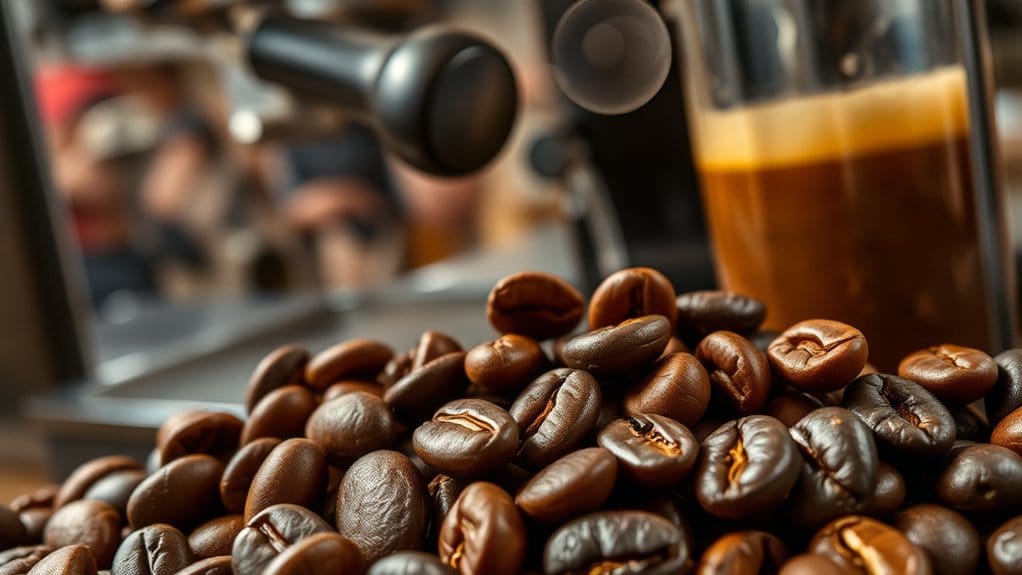
When you compare espresso to other brewing methods, it’s like watching a high-speed race versus a leisurely stroll.
Espresso’s short brewing time makes it more sensitive to degassing. You’ll need to wait about five days to a week for the best flavor. Otherwise, you risk weak or sour notes, not what you want in your shot!
On the flip side, drip coffee and pour-over methods allow for longer brew times, which can mask the effects of insufficient degassing. They’re like a nice, slow picnic, letting flavors meld together.
Moreover, monitoring caffeine consumption is crucial, as excessive intake may impair the overall coffee experience.
Brewing the perfect cup of coffee isn’t just about choosing the right beans; it’s furthermore about fine-tuning your brew parameters to bring out the best flavors.
Start with the golden ratio of 1:18—one part coffee to eighteen parts water—but don’t be afraid to play around. Want it stronger? Try 1:15 or 1:12!
Adjust your grind size too. If your coffee’s tasting weak, grind finer. If it’s bitter, coarser it is!
And remember, timing’s everything. A good espresso shot should be around thirty seconds.
Use scales, timers, and taste your way to perfection. Investing in a quality grinder enhances the overall coffee flavor experience, so get ready to experiment, as there’s always a new flavor waiting to be revealed in your next cup!
Yes, you can roast coffee beans at home for ideal degassing. Just make sure you control temperature and duration, allow proper resting time, and monitor environmental factors to improve flavor and brewing consistency.
Altitude affects coffee degassing by altering bean density. High-altitude beans retain CO₂ longer, needing more time to degass, whereas lower-altitude beans release gas faster, allowing you to brew sooner for ideal flavor extraction.
Dark roast coffee beans degas the fastest, thanks to their longer roasting times creating more micro-cracks. Light roasts degas slowly, trapping carbon dioxide longer, whereas medium to dark roasts release higher absolute amounts of CO₂.
Yes, your grinding method definitely influences degassing rates. Finer grinds release carbon dioxide more quickly because of increased surface exposure, whereas coarser grinds retain gas longer, impacting freshness and flavor preservation in your brewed coffee.
Yes, you can expedite degassing by storing coffee in airtight containers with one-way valves, keeping it in cool, dark conditions, and gently agitating beans occasionally. These methods help maintain flavor as well as allowing gases to escape effectively.